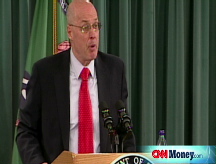Key lending market flattens out
Fed's corporate funding program is nearly a month underway, but private investors have been resistant to join in the central bank's efforts.
NEW YORK (CNNMoney.com) -- A key market for business lending expanded only slightly last week, despite a massive Federal Reserve lending effort.
According to a Fed report on Thursday, the amount of so-called commercial paper that was sold in the seven days ended Nov. 11 rose by just $288 million, or less than 0.2%, to a seasonally adjusted $1.6 trillion.
The most recent week's expansion represents a huge drop off from the previous week, when the amount of commercial paper sold rose by $50.5 billion. And the week before that, the market expanded $100.6 billion.
"The commercial paper market is going to take a long time to get back to normal," said Bill Larkin, portfolio manager at Cabot Money Management.
Commercial paper is short-term debt that big businesses and financial institutions sell primarily to money-market fund managers and other institutional investors. The companies use the loans to fund day-to-day business operations. The market for it, particularly for three-month paper, dried up after the collapse of Lehman Brothers in mid-September.
On Oct. 20, the Fed began to buy up hundreds of billions of dollars of high-quality, three-month commercial paper through its Commercial Paper Funding Facility. The program immediately boosted the market, but free market investors have not joined in the Fed's efforts to buy up corporate debt.
Last week, a separate Fed report showed that the government bought nearly $100 billion of commercial paper, but total commercial paper on the market rose by half that amount that week. The Fed will announce how much commercial paper it bought in the past week at 4:30 p.m. ET Thursday.
The New York Fed said on its Web site that the purpose of the Commercial Paper Funding Facility is to boost liquidity in the commercial paper market "by providing greater assurance to both issuers and investors that firms will be able to roll over their maturing commercial paper."
But private investors don't seem too assured. Lending lags behind levels from a year ago when $1.9 trillion changed hands, despite the Fed's attempt to backstop the market.
With the economy likely in a recession, investors have no appetite for risk. Commercial paper used to be viewed by investors as one of the least risky asset to hold. But now even the most conservative investors, such as money-market fund investors, are unnerved by the credit crisis and don't want to be holding onto debt for a corporation that might not be around when the loan expires.
"Money-markets are in preservation mode right now," said Larkin. "They're only buying Treasurys."
Several dozen companies registered for the Fed's program, including General Electric Co. (GE, Fortune 500), which is the largest issuer of commercial paper. Other companies subscribing to the program include Morgan Stanley (MS, Fortune 500), car and home lender GMAC (GMA), American Express (AXP, Fortune 500), and bailed-out insurance firm AIG (AIG, Fortune 500).
But all of those companies have something in common - they have the resources to issue high quality paper. Corporations with riskier debt are the real companies that are struggling for day-to-day financing, but they cannot participate in the Fed's funding facility.
"For lower-credit players, they're going into survival mode," said Larkin. "Their only options are to hoard cash and cut expenses or go to Washington and beg."
Lower quality paper made up just 2.8% of total business debt borrowed in the past week. Critical three-month funding in the so-called lower quality A2/P2 market made up less than 0.2%.
Furthermore, borrowing rates for A2/P2 paper are as much as 4-1/2 times higher than rates for high-quality AA paper, so smaller companies that can access the market are forced to pay a punishingly high interest rate for the loan.
"Struggling companies for which we still don't know the depth of the hole are waiting for a turn in the market," Larkin said. "They can probably still get deals done but with painful conditions." ![]()


